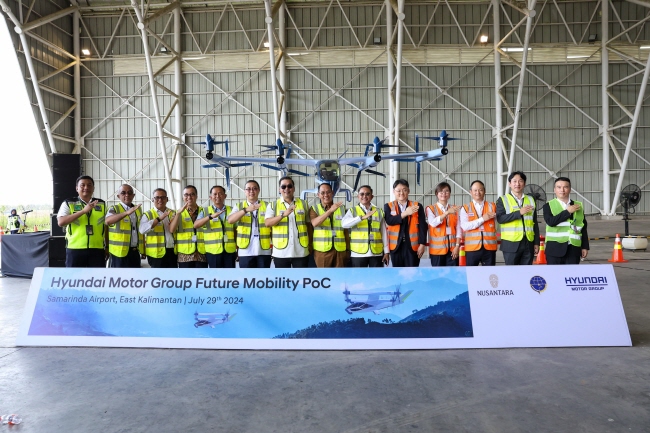
Hyundai Motor and Kia have made their mark in Indonesia by introducing innovative mobility technology that connects land and air transport.
On the 29th (local time), Hyundai and Kia held a public event at Samarina Airport near the new capital of Indonesia to showcase integrated mobility technology combining land and air travel, marking the start of their active endeavors.
The event was attended by government officials from the Indonesian Ministry of Transportation and the new capital office, as well as Hyundai and Kia AAM project leader Kim Cheol-woong.
Indonesia is known for its vast land area and its thousands of islands, making it challenging to develop road transport. This presents significant growth potential for AAM (Advanced Air Mobility) business.
The technical demonstration conducted on this day was designed to adapt Hyundai and Kia’s on-demand transportation system ‘Shuttle’ and future air mobility services to real customer usage environments while preparing for future advancements.
It emphasizes providing a more free and comfortable mobility service for passengers through an integrated mobility solution that connects land and air transport.
Initially, government officials listened to an explanation from Hyundai and Kia representatives about the Shuttle application, which allows experience of the reservation and payment processes for integrated land-air mobility, including AAM.
Then, they used the Shuttle app to call a modified Hyundai County EV bus in line with the technology demonstration and moved to the main event venue, the airport hangar.
The AAM aircraft demonstration utilized the OPPAV (Optimized Personal Air Vehicle) prototype from the Korea Aerospace Research Institute. Hyundai and Kia participated in developing the core technology of OPPAV’s electric powertrain, which realizes distributed electric propulsion technology by independently driving multiple motors and batteries.
OPPAV successfully took off, flew approximately 2 km along a flight path pre-agreed with the Indonesian Ministry of Transportation, and safely reached its destination.
At the event, a scaled model of the new AAM aircraft, ‘S-A2,’ which is being developed for commercialization in 2028, attracted significant attention. S-A2 was first unveiled at CES 2024 held this January, marking four years since Hyundai and Kia presented their first vision concept ‘S-A1’ in 2020.
Indonesian government officials expressed interest by asking questions about the design and performance of the S-A2 aircraft.
Kim Cheol-woong from Hyundai and Kia’s AAM business development emphasized that “the establishment of future air mobility requires not only aircraft development but also the cooperation of the entire aviation industry.” He added that “Supernal and Hyundai and Kia will continue to research and develop towards achieving AAM commercialization by 2028 and will maintain strategic alliances with the Indonesian government and institutions to lead the future AAM ecosystem.”
Meanwhile, Hyundai has been collaborating for AAM commercialization in Indonesia, having signed a memorandum of understanding with the Indonesian Ministry of Transportation and the new capital office for the development of future mobility solutions back in 2022.
Lee Sang-jin daedusj@autodiary.kr

